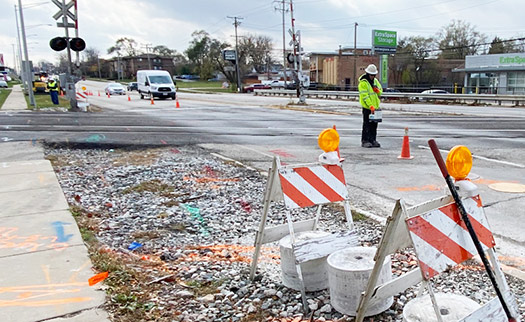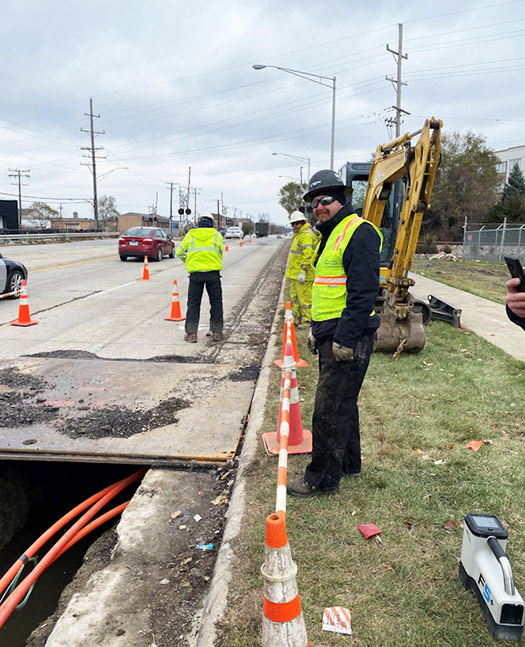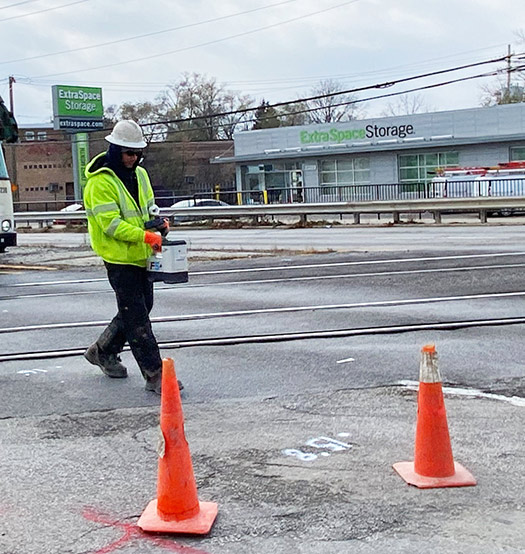January 2024 Vol. 79 No. 1
Features
Overcoming challenging HDD locating requirements
By Jeff Griffin, Senior Editor
Those involved in underground utility construction agree that knowing the location of existing buried utilities is essential before starting to excavate, drill or bore.
Calling 811 will arrange for utilities in public right-of-way to be located and marked, but 811 will not locate on private property, and many times more than just the marked route of pipes and cables are needed.
Electric Conduit Construction (ECC) recently completed a project in Alsip, Ill., which included running fiber optic cable 1.74 miles under roads, highways, canal and railroad track. Horizontal directional drilling (HDD) technology was used because the right-of-way was laced with existing utilities of all types, including fiber, power, gas, water, sewer and cables.
“It is the practice of ECC to pothole the line of lay every 25 feet and at every marked foreign utility.” said Superintendent Arnie Johanningsmeier.
This practice has stood the company well. In 2021, ECC submitted over 100,000 dig tickets and recorded only four utility strikes, and those strikes were on unmarked utilities. Potholing takes time, especially when core boring through base pavement and reinforcing rod, but it is necessary. It enables the crews to positively identify every utility and allows them to see the drill head as it passes below the utility.
HDD projects go smoothly if the operator and drill head tracker can pick up the signal being transmitted from the transducer on the drill head.
15 bore shots
This fiber project required 15 drill shots over the 1.74-mile line of lay, along with open-cut work, handholes and casing installation. Finally, the fiber was pulled, spliced, tested and terminated. The HDD rig used in this work was a Vermeer D-40 x 55. This designation stands for 40,000 psi of downhole force and 5,500 foot-pounds of rotational torque.
On this project, all went well on 14 of the 15 drill shots, but on a 460-foot shot under a railroad, the signal was lost. This shot had a profile that required the drill to be 16-feet deep before the
roadbed zone of influence, then flatten and maintain that depth until the drill was at the opposite side of the tracks. Then the drill tracked to the surface in the remaining 200 feet.
This drill path was near parallel distribution-power conduits, a steel water main and a steel gas main, both under cathodic protection, as well as the railroad tracks themselves that may have been carrying induced current from overhead power lines.
“When a tracking signal is lost, ECC policy is to immediately stop drilling. The shot was barely 60 feet into the bore. Vermeer and DCI were called and asked to analyze the situation and suggest a solution,” said Johanningsmeier.
“The DCI Falcon rep was onsite within hours of the call. He walked the bore path, made note of possible interference sources, especially the cathodic protection which operates between 10-14 KHz. By selecting a frequency outside of this range, he was able to receive a clear signal. The bore proceeded smoothly and was completed on time.
“If DCI had not solved this problem, ECC would have resorted to wireline technology,” said Johanningsmeier. “This would have involved additional personnel, equipment and time delay getting them to the site. DCI’s assistance saved money and time.”
Thankfully, this was the only section that caused tracking problems, a testimony to the reliability of DCI’s signal technology.
Final details
At the open-cut sections, parallel utilities had to be supported while ECC completed the conduit work. At the canal, highway and railroad crossings, the bore was enlarged to 10 inches to accommodate pulling back a 6-inch conduit.
This conduit became the casing for the fiber optic cable, which is critically important for the maintenance of the cable. In the event of an outage, slack can be pulled from handholes to enable splicers to repair the damage and get the network online again. Without a casing, this task becomes very difficult and time consuming.
All casing ends were sealed with silicon foam to keep the interior free of debris and animal pests. Topside, the cables were marked with posts set in concrete. An arrow parallel to the line of lay marks the path of the cable.
Handholes were set according to the drawings to store slack fiber for maintenance purposes.
“Safety protocols were followed closely,” Johanningsmeier said. “There were many opportunities for an injury. Everything from a slip, trip, sprained ankle or soft tissue injury, to the very real danger of electrocution from the drill head puncturing a distribution duct package.
“ECC takes no chances with anything that could injure a worker. Health and safety are good for everyone. We thank these crews for their professionalism, safety awareness and attention to detail. Despite the challenges, this was a job well done. Finally, fiber was pulled, spliced, tested and terminated.”
Based in Elburn, Ill., Electric Conduit Construction projects include underground and overhead utility construction, civil construction, intelligent transportation systems, emergency call systems and maintenance programs.
FOR MORE INFORMATION:
Electric Conduit Construction, (630) 360-7903, electricconduitconstruction.com
Digital Control Inc., (800) 288-3610, digital-control.com
Vermeer Corp., (888) 837-6337, vermeer.com







Comments